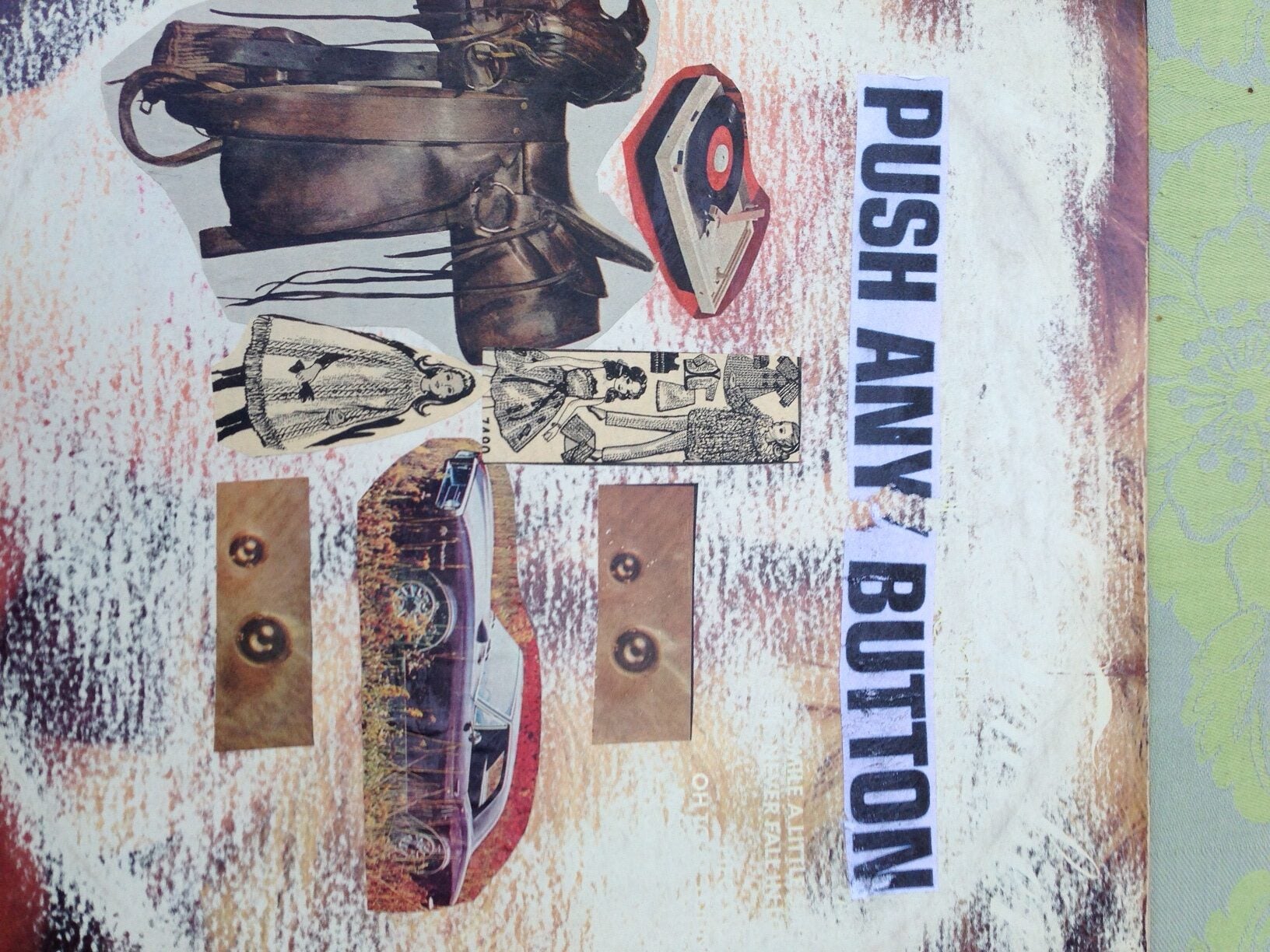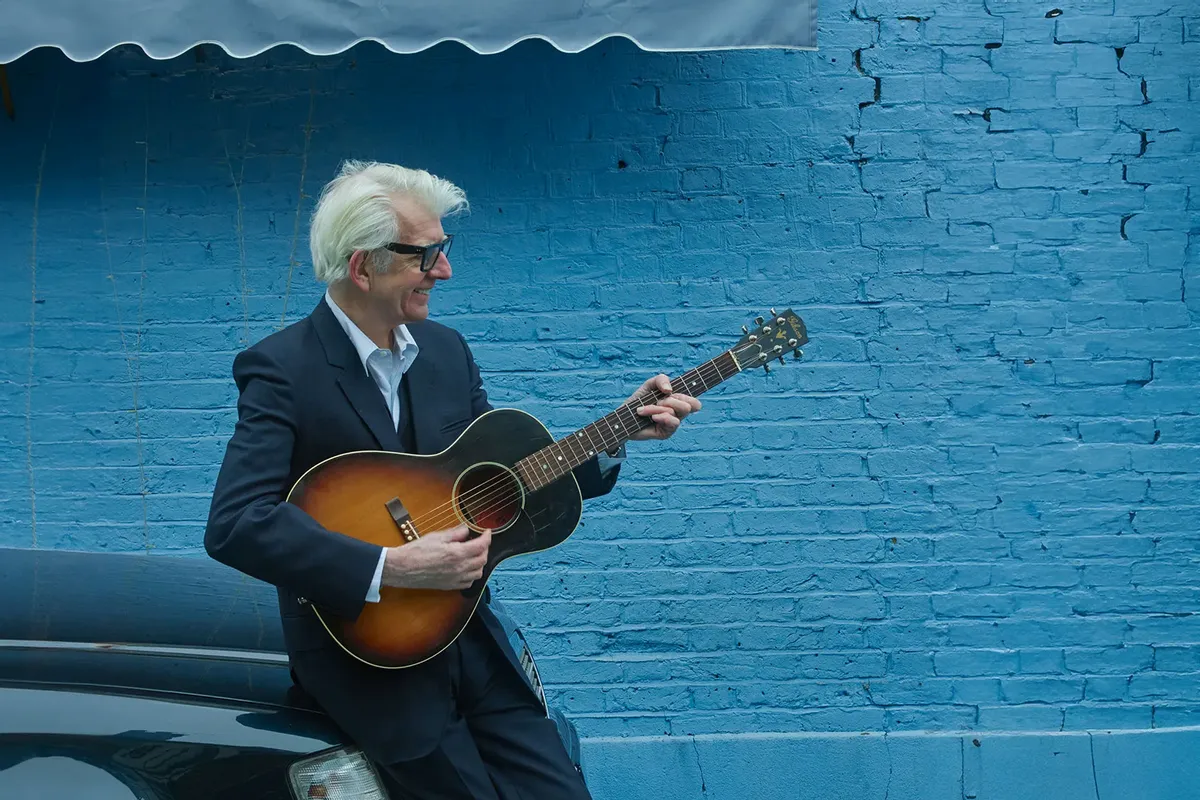We talk with comedy writer Simon Rich about his new collection of short stories, “Hits and Misses.” Plus, musician Sam Phillips on her cinematic album, “The World On Sticks,” and Tedium’s Ernie Smith on the history of hidden tracks on albums.Also, writer and journalist C. Brian Smith traces the sordid saga of road rage.
Featured in this Show
-
Simon Rich's Surreal Short Stories Are Often Very Personal
Simon Rich has been described as “one of the funniest writers in America.” His new collection of short stories is “Hits and Misses” and it’s inspired by Rich’s real experiences in Hollywood.
The opening story is called “The Baby,” It’s a Kafkaesque, surreal tale filled with a lot of dream logic. The story is about a struggling novelist named Ben. His wife is pregnant and Ben is frantically trying to finish up his historical novel about General Custer before Sue gives birth.
As he’s working on his book, Ben checks out the sonogram and discovers two things about his unborn child. The first is that it’s going to be a boy and the second is that the fetus has a pencil. As Dr. Kowalski explains, that means that Sue is going to give birth to a writer.
While everybody else is pretty excited about the news, Ben can’t help but feel competitive with his unborn child, especially when he learns the fetus is writing what may not be just a good novel but could possibly be the Great American Novel. And it too is about General Custer.
Like father, like unborn son.
Rich told WPR’s “BETA” how he turns off the rational part of his brain to create these fantastical, funny stories:
“They’re always very personal stories but I don’t really realize how personal they are when I’m sitting down to write them. So in hindsight, this story is very autobiographical because I wrote it when my wife was pregnant. And I, like the protagonist of that story, am a writer and I was dealing with all the usual things that expectant parents deal with — what does this mean for me, you know, I’m handing the baton to a new generation, does this mean my life is over?
“And I was dealing with all those sort of insecurities but I didn’t sit down with the goal of finding a metaphor, I just kind of wrote what I felt that day. And it was, you know, what if this kid inside that womb is a better writer than I am? And what if he’s writing right now?
“Of course, it ended up not even being a boy. So your characters always, I think, whether you want to admit it or not, have something in common with yourself. But I think writing from a surreal point-of-view, it allows me to have, ironically, enough distance from myself that I’m able to be a little bit more emotionally honest maybe than I would be if I was writing a straight-ahead memoir, which is actually something that I’ve never even attempted.”
Another short story in “Hits and Misses,” “Riding Solo: The Oatsy Story,” is a tell-all memoir told from the point of view of Paul Revere’s horse, Oatsy. And although Oatsy could be very bitter about Revere receiving all of the credit for the Midnight Ride, Oatsy says that that’s not the case. A great deal of the comedy in this story comes from the suitably equine diction that Rich has bestowed upon Oatsy.
This makes the “BETA” team think that if the writers of the 1960s TV sitcom, “Mister Ed,” had given the title character the very same kind of diction, the show might still be on the air.
“That’s a great show and a missed opportunity for them,” Rich replied.
Many of Rich’s stories contain elements of tragedy.
“I guess I’m always interested in characters that are in some kind of predicament. I’m also interested in characters who are naïve in some way. Most, if not all, of my protagonists know less than the reader knows.
“They tend to be inanimate objects or animals or have some kind of flaw, you know, in the case of the struggling novelist in ‘The Baby.’ In that story, he has this deep insecurity. So I always try to write from a place of weakness and frailty. So I think that that sort of lends itself to that tragicomic tone.
“But I try to give my characters redemption most of the time. I would say occasionally one of my stories will have a pretty bleak ending but typically, you know, the character learns something or achieves some kind of success by the end.”
Rich was one of the youngest writers ever to work for “Saturday Night Live” and he’s also worked as a staff writer for Pixar. He’s been able to apply lessons learned from both those experiences to his fiction.
“Pixar, I think, really had a big effect on my storytelling strategy just because they’re so rigorous with their character arcs and with their narrative structure. And so I think I just learned a lot there about how to tell a story with a beginning, a middle, and an end. So I feel really fortunate for that,” he said.
“The big thing ‘SNL’ taught me was just kind of how to imitate different idioms. You know, when you’re writing satire, it’s really important to capture in a sentence a certain tone or style. And since I tend to move around from genre to genre, imitation is a big part of what I do. For example, in one of my collections, I have a Sherlock Holmes story. Or I’ll do a Lewis Carroll knockoff. I think I’m using those ‘Saturday Night Live’ muscles whenever I’m trying to truly satirize a specific voice or writer.”
-
Singer Sam Phillips' 'World On Sticks' Explores Lost Connections With Nature, Other Humans, Ourselves
Singer-songwriter Sam Phillips has been keeping busy these days. Among other things, she’s been making music for television.
You may know her work from “Gilmore Girls.” Phillips is the woman behind those distinctive musical cues, which have been dubbed the “la la” songs.
But she hasn’t forgotten about making albums. Phillips has just released her 10th studio album, “World on Sticks.”
“It was a concept that slowly gathered itself over the last few years,” Phillips told WPR’s “BETA.” “And I think the song or that title (‘World on Sticks’) in and of itself is the beginning of a feeling that something needs to change, you know, kind of that uneasiness. And I think that as time went on, yes, all those thoughts came into my mind about the Earth, about life as we know it.”
In the “World on Sticks” press release, Phillips is quoted as saying that “troubles on the outside can be reflections of troubles on the inside.”
During her conversation with “BETA,” Phillips expanded on this quote.
“We have earthquakes out here in Los Angeles. And they always say that the cats can feel the vibrations of the Earth, I think that dogs can, too. And they start reacting before we can feel the earthquake. And I feel like as songwriters, we’re funny creatures. If we’re paying attention, we can feel the rumblings of things before they hit us. And it seems that we’re in a really interesting time in humanity in this country, a very difficult time, you know. And a time of decisions, of deciding, you know, like the last song that I wrote for the record is called ‘How Much Is Enough.’ And I thought that this was a good question, it deserved a song. And how much is enough, we all have to figure that out for ourselves, we have to ask that question I think to a lot of areas of our lives — not just our political scenario here but also how much is enough for me personally of material things, how much can I take, how much information can I have coming at me at any given time?”
Many of the songs on “World on Sticks” come across as an attack on what we are doing to our natural landscape but “How Much Is Enough” seems to be an attack on our modern media landscape, especially when Phillips sings the lyrics: “Someone keeps giving us the wrong numbers. We’re not supposed to know what’s true.” Which raises the question: Does Phillips see this song as an attack on contemporary media?
“Not an attack on contemporary media,” Phillips said. “I think it really is a question that I think everybody has to answer for themselves. How much can you take? How many lies can you take? How are you going to find the truth? Do you have to find the truth for yourself in your life first before you can find the truth for larger situations? For instance, you know, when I was a kid growing up in Los Angeles, the air was really bad because we didn’t have unleaded fuel at that time. And there was a lot of smog, a lot of pollution. And thank goodness that there were people in the state that lobbied for cleaner air and regulations that helped the cars, the fuel, everything become cleaner. Because when I was a little kid, I would have to lie down because my chest would hurt. You’d just be out playing as a kid and it was so smoggy and so bad, you’d have to lie down. And, you know, I realized maybe in other areas of the country, the air never got that bad because people weren’t growing up in cities and maybe when their emphasis is on, you know, jobs and money, maybe they don’t understand, they’ve never lived through the air quality being so bad that you have to lie down because your chest hurts.”
“And I think we have to be gentle with each other because I don’t know at any point, especially on social media, I don’t know what someone doesn’t know, you know. And I think we have to gently bring each other along because people are fighting for what they know is right and what they think is true. But maybe we have to give this time and find out a little more about the situation before we yell at each other in cowardice on the internet.”
Phillips collaborated with writer-director Dave Rygalski — former writer for both David Letterman and Jay Leno — to assemble a collection of jittery film clips of word and picture collages that she made by using vintage album covers. Phillips refers to the agitated footage as “jittervids.”
The opening song on “World on Sticks” is “Walking Trees” and there’s an interesting story behind what inspired Phillips to write this one.
“I was passing this tree every day going to the studio. And we were going through a really bad drought in California. And it just seemed that this tree was drooping. And I started reading about trees and how they help each other with their roots underneath the ground,” Phillips said. “They can reach out to a dying tree and help that other tree. And it was funny because as soon as it started raining, he seemed happier. And I think I was imagining him also looking at me, or I imagined this situation, kind of taking a little pity on the human person, you know, oh, that poor little person, they’re only around for a third of my lifetime and they’re all worried, and they’re going through what they’re going through down there. And wouldn’t it be nicer if they could be a little more calm, if they had more perspective, if they could be up at this height or if they could live 200 years or 150 years and have that perspective? And so of kind of trading places with the tree thinking, you know, we are in a funny predicament as humans and we are kind of like walking trees. That’s what he would call me. ‘Oh, there’s that walking tree again.’”
Many of the songs on “World on Sticks” have this very big, very industrial drum sound; the title track “World on Sticks” is a perfect example.
The drum intro has this very dystopian feel. And yet there are also these very beautiful, very lush string arrangements on many of the songs. It kind of feels like Phillips has created this running thread of sonic cognitive dissonance over the course of the album. On the one hand, the booming drums convey fear and horror, yet the lush strings give us hope and optimism.
Does Phillips agree with this interpretation?
“I think that’s absolutely right,” Phillips said. “And I think that’s the teetering of the ‘World on Sticks,’ the drums pulling it. And when I first started this record, I asked Jay Bellerose, the drummer that I’ve been privileged to work with for the last decade, I had him play drum performances and then I wrote and edited to those performances. And one of the songs called ‘I Wanna Be You,’ that phrase came out of his drum playing.”
-
Uncovering The History Of Hidden Tracks
Ernie Smith is the editor of Tedium, which explores “the dull side of the Internet.” And he’s on a mission to take a deep dive toward the absolute end of the long tail. One of these said missions found him uncovering the history of hidden tracks on vinyl records and CDs.
Smith told WPR’s “BETA” that “a hidden track is basically any piece of audio on a record that’s not listed on the track list. Sometimes, it can be something very short like a vignette. It can be an actual, out-and-out single that just they decided to add after the album’s record sleeve had been printed.”
According to Smith, the very first hidden track is probably The Beatles’ “Her Majesty.”
The 23-second song was written and performed by Paul McCartney and was originally going to be part of the medley that appears on side two of “Abbey Road.” However, Smith explained there was no good place to fit it into the medley so McCartney told engineer John Kurlander to leave it off of the album. Kurlander followed McCartney’s instructions but later added it to the very end of the album, following a few seconds of silence.
“The Beatles always picked up on accidental things. It came as a nice little surprise there at the end and he didn’t mind,” Kurlander said in an interview.
The inclusion of “Her Majesty” on “Abbey Road” launched the hidden track micro-genre.
“It actually started a bit of a trend,” Smith said. “It was probably more pronounced during the CD era but there were definitely examples of this during the vinyl era. One that really kind of stands out is Monty Python. They basically created an album called ‘The Monty Python Matching Tie and Handkerchief.’ It came out in 1973 and the trick of the record is that both sides of that record were listed as Side Two. One of the sides of the record actually had a double groove to it.”
This double groove was the result of the record being mastered with two concentric grooves on side two so that different content would be played according to where the stylus was placed down on the surface of the record.
Python member Michael Palin told an interviewer that the Pythons “had these visions of stoned fans — of which there were a lot in the early ’70s — having the shock of their lives when brand new material was playing on a record they had had for months. Some people thought there was an alternative version because they would hear talk of these mysterious sketches that they had never heard on their record. It drove people mad. This was precisely why we did it, of course.” Fittingly enough, that record was cut at Abbey Road Studios.
While the phenomenon got its start in vinyl, Smith makes the case that CDs contain more interesting hidden tracks than vinyl records do.
“There was more to mess with. CDs being a digital format, they allowed you to do things like mess with the track numbers. You could emphasize silence a little bit more. Because compact discs, they held more stuff so you had more white space to work with,” he said.
“And one of the things they messed with is called the pre-gap,” Smith explained. “Basically … if you take a CD with a pre-gap track on it, you can actually rewind it back beyond zero-zero-point-zero-zero and find a whole other song or two. A really good example of a band that used this really well is the band Ash. They were a ’90s alternative rock band and on their first record, they actually included one of their early singles that was recorded before they did this album.”
One of the most famous hidden tracks appears at end of Nirvana’s album, “Nevermind.” It’s called “Endless, Nameless.” And it shows up 10 minutes after you think the album has ended.
As Smith explained, “Nirvana specifically designed it in such a way that it would sound like the end of the record hit, there would be 10 minutes of silence and then all of a sudden, the listener would get blasted with this loud, abrasive rock track. It became the high-water mark for hidden tracks. It was the one that really made the concept of hidden tracks something that a lot of bands did. Because it was such a popular album and because it was a relatively novel trick at the time they did it. I don’t think it was intended to be anything more than just the thing that Nirvana finished this album off with. It just happened to become much more of a cultural phenomenon because Nirvana as a whole became a cultural phenomenon.”
So why aren’t we seeing so many hidden tracks these days? Are we just not looking hard enough?
“The hidden track has been replaced by the bonus track,” Smith explained. “These days, when it comes to streaming, it’s harder to catch someone off guard with a piece of music. So I think that while the hidden track is less relevant than it once was.”
Still reading? Great.
Since this is a “BETA” story about hidden tracks, we thought it was only fitting to hide some hidden tracks at the end of the story. And these just aren’t any hidden tracks. These are four hidden tracks that, according to Smith, transcended their “hidden” status.
-
Fury Road: The Ongoing Saga Of Road Rage
If you’ve ever felt your blood pressure rise while you’re driving or if you’re car horn gets a workout during your commute, rest assured, you are not alone. The anger, aggression and anxiety commonly known as “road rage” affects nearly 80 percent of drivers in the United States.
Writer C. Brian Smith set out to investigate why in an article for MEL magazine. Smith tells WPR’s “BETA” that since 2004, road rage related fatalities have increased tenfold. He also says it’s tough to measure these incidents.
“It’s hard to say because a lot of these crimes don’t get reported,” Smith said. “The most common reasons are weaving between lanes, cutting people off.”
Even with a general spike in outrage altogether these days — whether it be online or otherwise — Smith argues road rage stands alone.
“I think the issue specifically with road rage is that it impedes normal social communication. So, if someone cuts you off in a Starbucks, you’ll likely say ‘I’m so sorry’ and handle it in the moment,” Smith said. “But, you can’t have that interaction in the car. I think road rage is unique that way because it forgoes the normal communication tools that we have.”
Smith outlines the history of road rage, which he traces as far back as the 19th century.
“The earliest reference to it was actually an English nobleman, a Lord Byron. He wrote to his friend Thomas Moore in 1817, ‘Last week I had a row with a fellow in a carriage who was impudent with my horse and so I gave him a swinging box in the ear which sent him to the police.’”
The issue was so ever-present in the 1950s that even Disney addressed it. In a Goofy cartoon from the period, they highlighted the Dr. Jekyll and Mr. Hyde transition that happens when some people get behind the steering wheel.
“It features Goofy as Mr. Walker, an everyman, good-natured suburbanite who just transforms into a monster behind the wheel,” Smith said.
While the pattern of behavior has a long, sordid history the term “road rage” wasn’t coined until the 1980’s by the local Los Angeles media after an onslaught of vehicular crime in southern California.
“There were a series of violent incidents on LA freeways of people just shooting each other,” said Smith.
Smith cites author and psychologist Peter Marsh who wrote “Driving Passion: The Psychology of the Car” who writes there is a more primal instinct at play with road rage.
“(Marsh) explains that it’s actually the design of the headlights that are problematic because they’re considered these threatening eyes, which is why a lot of incidents occur when people fail to dip their high beams,” said Smith. “He says that headlights give cars an animalistic quality, as do the four wheels, so it makes it look like they’re horses bearing down on you.”
Marsh’s book also delves into the phenomenon that people view their cars as an extension of their home, which can lead to an overprotective state.
“Any threat to that dominance that we have that we feel in the car, like a tailgating car or a truck flashing its high beams, it provokes this aggressive reaction within us,” said Smith. “People who are usually well-mannered suddenly start raising fists and freaking out because people are encroaching in your personal space.”
Smith investigated ways to prevent road rage. He spoke to a former San Diego police officer about ways to battle it. The officer said most road rage incidents occur because most drivers assume it is the other driver’s fault.
“He says the simple answer is to concentrate completely on your own driving and not to make eye contact with the people around you,” Smith said. “He suggests asking ‘what would the Dalai Lama do?’”
Another solution might come in the form of advanced technology and self-driving cars.
“A lot of people say autonomous vehicles are the answer to a lot of human-based errors on the road,” Smith said. “Just get humans out from behind the wheel.”
Episode Credits
- Doug Gordon Host
- Doug Gordon Producer
- Adam Friedrich Producer
- Steve Gotcher Technical Director
- Simon Rich Guest
- Sam Phillips Guest
- Ernie Smith Guest
- C. Brian Smith Guest
Wisconsin Public Radio, © Copyright 2025, Board of Regents of the University of Wisconsin System and Wisconsin Educational Communications Board.




